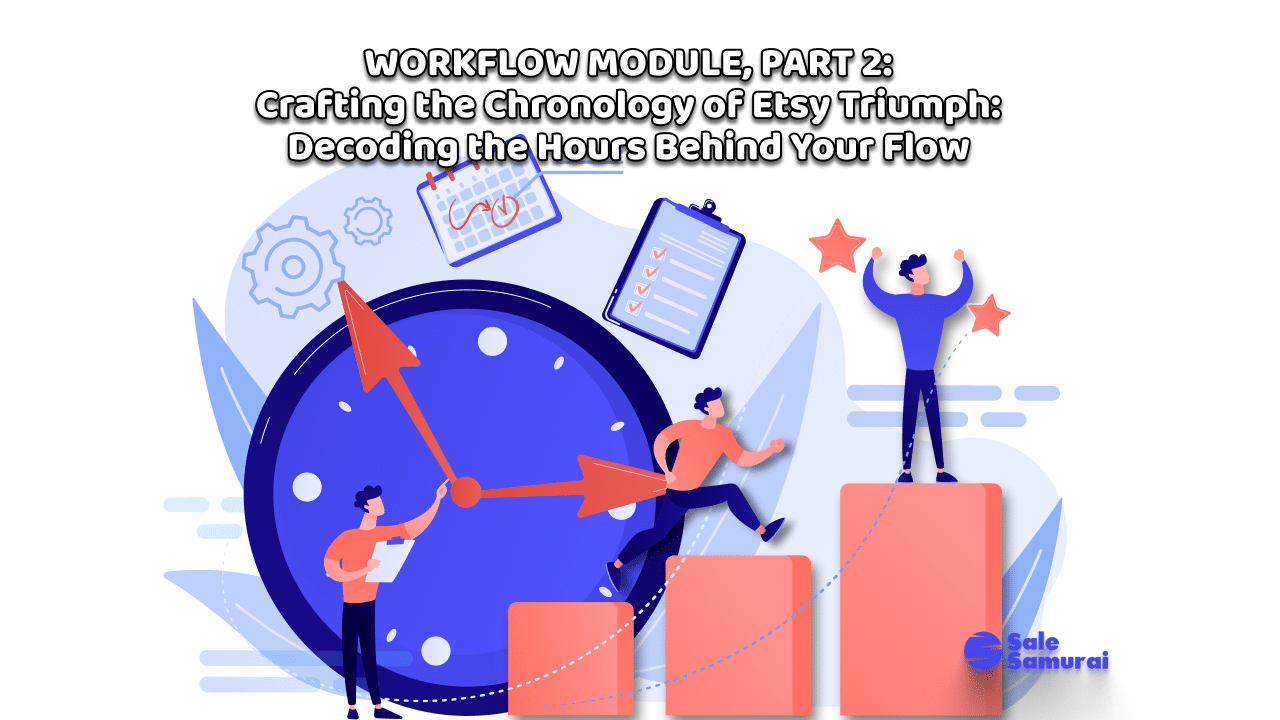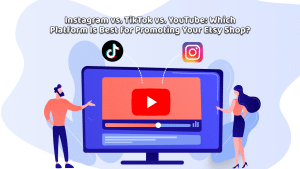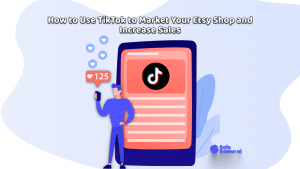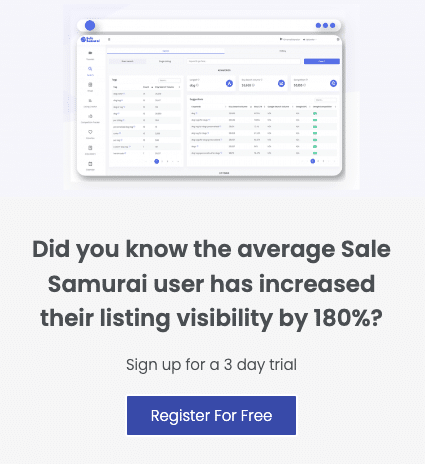
Greetings, Etsy maestros! In our previous discourse, we delved into the intricacies of fine-tuning your Etsy workflow. Today, our odyssey ventures further into the temporal dimensions that underpin your entrepreneurial journey. Fasten your seatbelts as we navigate through the daily rituals that pave the way for your Etsy empire to flourish.

1. How to Get Your Process Sorted to Organize Your Etsy Workflow (Approx. 2-3 Hours, one time)
Embarking on a journey of efficiency, allocate 2-3 hours to initiate the organization of your Etsy workflow. Here’s a more detailed breakdown of the tasks within this phase:
- Define your processes and create task templates (1 hour): Start by delineating the key processes in your Etsy workflow. Create templates for repetitive tasks to streamline future efforts.
- Set up a daily rhythm that aligns with your work style (1-2 hours): Tailor your daily routine to harmonize with your most productive periods. This involves a bit of experimentation to identify your peak hours.
- Establish routines for seamless operations (30 minutes): Identify recurring tasks and establish routines for executing them. This could include specific times for responding to messages, updating listings, and handling other routine activities.
This phase forms the bedrock of a well-organized Etsy venture, ensuring that your daily tasks align seamlessly with your overarching business objectives.
2. Open a Separate Bank Account for Your Etsy Shop (Approx. 1 Hour, one time)
Fortify your financial fortress by dedicating an hour to the following steps:
- Research and select a suitable bank for your Etsy transactions (30 minutes): Explore different banks to find one that aligns with your business needs. Consider factors such as fees, accessibility, and integration with financial tools.
- Fill out necessary paperwork for the new account (20 minutes): Complete the required documentation to open a dedicated bank account for your Etsy shop. This step ensures a clear demarcation between personal and business finances.
- Ensure seamless financial tracking for your business (10 minutes): Set up tools or processes to track your business finances efficiently. This could involve integrating your Etsy account with accounting software or regularly updating a financial spreadsheet.
This step guarantees that your financial affairs are well-structured and distinct from personal accounts.
3. How to Complete Competitor Research on Etsy (Approx. 2 Hours, Weekly)
Engage in strategic reconnaissance, investing approximately 2 hours weekly in the following tasks:
- Scrutinize competitor products and study customer reviews (1 hour): Dive deep into the products offered by competitors in your niche. Analyze customer reviews to understand what works well and areas for potential improvement.
- Glean insights to refine your own approach (30 minutes): Extract valuable insights from competitor strategies. Identify unique selling points and areas where you can differentiate your products.
- Explore strategies best suited for your niche (30 minutes): Tailor your approach based on the strategies employed by successful competitors. Consider A/B testing to understand what resonates best with your target audience.
Regularly conducting competitor research ensures you stay attuned to market trends and customer preferences. Fortunately, all of these tools are available on Sale Samurai!
4. Branding Your Etsy Shop (Approx. 1-2 Hours, one-time)
Crafting a compelling brand narrative takes time. Allocate 1-2 hours to meticulously execute the following steps:
- Choose brand colors, fonts, and packaging (45 minutes): Select visual elements that represent your brand. This includes colors, fonts, and packaging materials that align with your brand identity.
- Design or collaborate for a logo (30 minutes): Create a unique logo that serves as a visual identifier for your shop. You can either design it yourself or collaborate with a graphic designer.
- Define your shop’s mission and vision (30 minutes): Clearly articulate the mission and vision of your Etsy shop. This forms the basis of your brand personality and sets the tone for your interactions with customers.
This phase defines your shop’s identity, contributing to long-term brand recognition.
 5.
5.
5. Product Photos and Listings (Approx. 2-3 Hours, per item)
Creating an enticing visual journey for your customers requires meticulous planning. Spend 2-3 hours on the following tasks:
- Capture high-quality product photos (1 hour): Invest time in photographing your products in a visually appealing manner. Consider creating a DIY photo studio to enhance the quality of your images.
- Compose engaging product descriptions (45 minutes): Write compelling and informative product descriptions that highlight the key features and benefits of your offerings.
- Refine and optimize your listings (30 minutes): Regularly update your product listings to ensure they are optimized for search and accurately represent your products.
This phase is akin to curating an art exhibition, where each item tells a compelling story.
6. Daily Tasks as an Etsy Shop Owner (Approx. 1-2 Hours, Daily)
Navigate your daily responsibilities with finesse—reserve 1-2 hours daily for the following tasks:
- Upload new products and manage listings (30 minutes): Regularly add new products to keep your inventory fresh. Manage existing listings to reflect any changes or updates.
- Respond to customer inquiries (30 minutes): Engage with customers promptly, addressing inquiries and providing excellent customer service.
- Check and adjust inventory (20 minutes): Ensure your inventory levels are accurate. Make adjustments to prevent order cancellations due to insufficient stock.
- Manage Etsy shop supplies (20 minutes): Keep a close eye on your supplies, ensuring you have sufficient materials for packaging and crafting.
This daily rhythm ensures the smooth functioning of your Etsy shop, fostering positive customer experiences.
7. Packing and Shipping Etsy Orders (Approx. 2-3 Hours, Weekly)
Efficient order fulfillment is crucial for customer satisfaction. Dedicate 2-3 hours weekly to the following tasks:
- Pack products for shipment (1 hour): Assemble and pack products securely, ensuring they are ready for shipping.
- Double-check orders and shipping details (45 minutes): Review each order to confirm accuracy. Verify shipping details to prevent errors.
- Ship orders promptly (30 minutes): Schedule shipments to ensure orders are dispatched promptly, contributing to positive reviews.
This phase is akin to conducting a symphony of organized operations, with each step contributing to a harmonious customer experience.
8. Update Inventory in Your Shop (Approx. 1 Hour Daily)
Maintaining an accurate inventory is a cornerstone of effective business management. Dedicate 1 hour daily to the following tasks:
- Record changes in supply, sales, and orders (30 minutes): Keep a detailed inventory log, documenting any changes in supply levels, sales, completed orders, and refunds.
- Update product statuses on your store (20 minutes): Reflect changes in product availability on your Etsy store to avoid discrepancies.
- Organize listings to identify duplications (10 minutes): Regularly review your listings to identify and eliminate any duplications or inconsistencies.
This meticulous approach ensures your inventory is well-managed, minimizing the risk of errors.
9. Promoting Your Etsy Store (Approx. 1-2 Hours, Weekly)
Amplify your Etsy presence through strategic promotion, investing 1-2 hours weekly in the following tasks:
- Create marketing materials (45 minutes): Develop engaging content for social media posts or email marketing campaigns to promote your store.
- Utilize store announcements (30 minutes): Leverage store announcements to inform customers of upcoming events, sales, promo codes, and giveaways.
- Plan and schedule social media posts (30 minutes): Create a batch of social media posts for the week and schedule them using a social media publisher.
Strategic promotion enhances your store’s visibility, attracting potential customers.
10. What Are Your Sales Goals for Your Shop? (Approx. 30 Minutes, Weekly)
Evaluate your progress towards sales goals with a weekly investment of 30 minutes in the following tasks:
- Analyze monthly sales performance (15 minutes): Review your monthly sales data, assessing your progress towards established goals.
- Adjust marketing strategies based on analytics (10 minutes): Use analytics to refine your marketing strategies and adapt your approach for optimal results.
- Monitor website traffic and social media engagement (5 minutes): Keep tabs on website traffic and social media engagement to gauge the effectiveness of your promotional efforts.
This regular analysis ensures that your store’s trajectory aligns with your overarching business objectives.
11. Update Your Etsy Listings (Approx. 1 Hour, Monthly)
Regularly refresh and optimize your Etsy listings with a monthly investment of 1 hour:
- Add new products or update existing ones (30 minutes): Introduce new products or refresh existing listings to cater to evolving market trends.
- Update product photos and descriptions (20 minutes): Ensure your product photos and descriptions remain engaging and relevant.
- Align your offerings with current market trends (10 minutes): Stay attuned to market trends and adjust your offerings accordingly.
This monthly ritual revitalizes your Etsy store, keeping it dynamic and appealing.
12. Organizing Your Etsy Workflow (Approx. 1-2 Hours, Weekly)
Cap off our temporal expedition by fine-tuning your Etsy workflow. Spend 1-2 hours weekly on the following tasks:
- Review your daily checklist and update processes (30 minutes): Regularly assess your daily checklist, refining processes to enhance efficiency.
- Incorporate insights and performance adjustments (30 minutes): Analyze performance data and make adjustments to optimize your workflow.
- Maintain a flexible approach to accommodate evolving business needs (30 minutes): Stay adaptable, allowing your workflow to evolve in response to changing business dynamics.
This ongoing refinement ensures your Etsy operation remains agile and responsive.
There you have it, savvy Etsy entrepreneurs! A meticulously detailed breakdown of the time investments required for each facet of your Etsy empire. Join us next week as we unravel the enigma of average time commitments for this Etsy odyssey. Until then, may your creativity flourish, and your business thrive!











